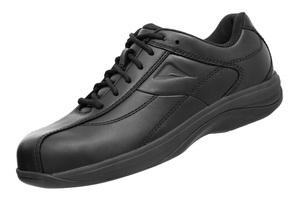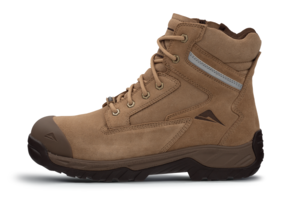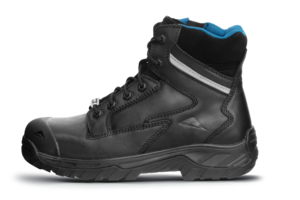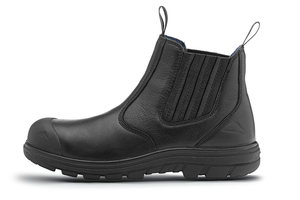
Benefits of Cushioned Safety Boots
Jun 10, 2021
Safety work boots come with different levels of cushioning and support, depending on which brand and style you look at. But does having high cushioning make a difference to your overall comfort at work? We'll explain why you should consider safety boots with a high level of cushioning and make choosing your next pair a breeze.
A study by Anderson et al (2017) found that most workers standing for long periods regarded cushioning and support as highly important for comfort in footwear. Moderate arch support and good cushioning in the heel and ball of the foot were also mentioned as essential for those on their feet all day (Anderson et al., 2020).
Experiencing lower body discomfort (lower back, limb or foot) in the workplace or after work is common but should not be considered normal nor should you have to tolerate this. Prolonged periods of standing or walking without decent footwear can accelerate the problem.
BENEFITS![]()
Better Body Alignment
A good pair of boots can help maintain the body's alignment from heel to head, reducing unnecessary stress and load.
Lower Risk of Injury
Cushioning through the sole will help absorb and distribute shock on the foot and up the body. Less impact on the feet and body helps prevent injury in the lower back, hips and feet.
Higher Productivity
With less pain from uncomfortable work boots, productivity will skyrocket as you'll be able to focus solely on work instead of sore feet.
BUYING WORK BOOTS
Choose work boots or safety shoes with ample cushioning in the heel and ball of the foot, as well as arch support for additional stability.
Cushioned Comfort
From high shock absorption and low compression to a balance between cushioning and rebound benefits, the cushioning materials used in the fabrication of our boots provide the perfect base for a long day's work.
Arch support through the midsole also makes these boots extra supportive.
Combinations of premium cushioning technologies are incorporated into our safety boots and shoes including INSULON, PORON, PU, BUNGEE and EVA foam.
Our Safety range is also approved for (E) Energy Absorption; the safety standard for shock absorption in under-heel cushioning.
If you'd like to find out more about each of these cushioning features, check out our Technologies page.
Why Supportive Sandals Matter More Than You Think Oct 13, 2025
National Podiatry Week Spotlight: Neda From Podiatry Beyond Shares Why She Recommends Ascent Oct 08, 2025
Why The Right Shoes Matter For Comfort & Safety Aug 20, 2025
The Perfect Pair for Dad, This Father’s Day May 21, 2025
Travel Ready Sneakers May 09, 2025
The Best Shoes For Nurses Apr 29, 2025
Treat Mum To Everyday Comfort This Mother’s Day. Your Thoughtfully Curated Gift Guide Apr 10, 2025
Why Wearing the Right Hiking Shoes Matters for Comfort and Safety Mar 27, 2025
The Best Recovery Sandals for Post-Workout Comfort Jan 22, 2025
Back to School Checklist: Don't Forget The Right Shoes
Shop Our Safety Range
Anderson, J., Williams, A. E., & Nester, C. (2017). An explorative qualitative study to determine the footwear needs of workers in standing environments. Journal of foot and ankle research, 10, 41. https://doi.org/10.1186/s13047-017-0223-4
Anderson, J., Williams, A. E., & Nester, C. (2020). Development and evaluation of a dual-density insole for people standing for long periods of time at work. Journal of foot and ankle research, 13(1), 42. https://doi.org/10.1186/s13047-020-00402-2
Nov 21, 2025Why Supportive Sandals Matter More Than You Think Oct 13, 2025
National Podiatry Week Spotlight: Neda From Podiatry Beyond Shares Why She Recommends Ascent Oct 08, 2025
Why The Right Shoes Matter For Comfort & Safety Aug 20, 2025
The Perfect Pair for Dad, This Father’s Day May 21, 2025
Travel Ready Sneakers May 09, 2025
The Best Shoes For Nurses Apr 29, 2025
Treat Mum To Everyday Comfort This Mother’s Day. Your Thoughtfully Curated Gift Guide Apr 10, 2025
Why Wearing the Right Hiking Shoes Matters for Comfort and Safety Mar 27, 2025
The Best Recovery Sandals for Post-Workout Comfort Jan 22, 2025
Back to School Checklist: Don't Forget The Right Shoes
Shop Our Safety Range
Anderson, J., Williams, A. E., & Nester, C. (2017). An explorative qualitative study to determine the footwear needs of workers in standing environments. Journal of foot and ankle research, 10, 41. https://doi.org/10.1186/s13047-017-0223-4
Anderson, J., Williams, A. E., & Nester, C. (2020). Development and evaluation of a dual-density insole for people standing for long periods of time at work. Journal of foot and ankle research, 13(1), 42. https://doi.org/10.1186/s13047-020-00402-2








